4
Methods of Teaching Science
CHAPTER OUTLINE
LEARNING OBJECTIVES
After reading this chapter, you will be able to:
List and explain the various methods of teaching science
Comprehend the merits and demerits of various methods of teaching science
Choose an appropriate method to teach a topic in science
Justify the selection of a method to teach a topic in science
INTRODUCTION
Science is fundamentally concerned with exploring and interpreting the world. It is a process of ordering and classifying, of formulations, explanations and hypothesis through experiments. Scientific knowledge is needed for any type of advancement in the society. Properly acquired knowledge of science develops thinking and reasoning power, curiosity, critical thinking and scientific temper.
In the words of Kothari Commission “if science is done badly, it is worse than useless. Science, taught badly, not only degenerates into superstition, but makes a negative contribution to education. To learn science is to do science.” In this context, teaching of science gains significant importance. For teaching of science, an appropriate method is needed. But, teaching is not everybody's cup of tea. It is not necessary that an intelligent person will be an effective teacher. For effective teaching, an appropriate method is needed which can be selected by the teacher on the basis of the age, characteristics and the need of children. Children as well as teachers differ in respect of their physical and mental development. Existing social, familial and classroom conditions act as intervening variables in the teaching-learning process. Thus, any teaching method is mainly governed by three factors—teacher, student and environment (Figure 4.1).
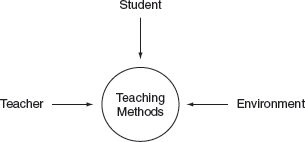
Figure 4.1 Variables Affecting Teaching Methods
SELECTION OF AN APPROPRIATE METHOD
Keeping in mind the above mentioned variables, certain principles can be laid which are mentioned below to guide a teacher for selecting an appropriate method of teaching science (Figure 4.2):
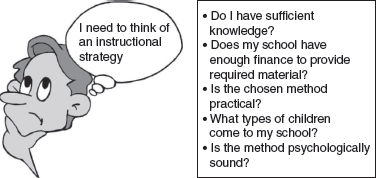
Figure 4.2 Selection of a Teaching Method
- Demographic characteristics of the class room—age, socio economic status, family background, etc.
- Practical utility of the method in achieving the objectives of science teaching.
- Infrastructure of the school—availability of apparatus and material in the school.
- Acquaintance of teacher with the method.
- Psychological aspects of the method—utilization of senses of the children.
METHODS OF TEACHING SCIENCE
Now, let us list down some methods of teaching science (Figure 4.3). Some methods are more of teacher centered and some are more of student centered. It is up to a teacher's discretion to choose the method which is most suitable for a certain topic in a certain class.

Figure 4.3 Methods of Teaching Science
The teaching methods, their merits and demerits are being given here one by one:
1. Lecture Method
Lecture means speech or talk. In a lecture method, the teacher is the speaker for most of the time and students are just passive listeners. The teacher prepares the talk on a topic and delivers it in the class. Most of the teachers do not encourage questions during the lecture. Instead, they give time at the end for questioning. In such cases, only mature students are able to retain the questions till the end. Younger students tend to either forget the question or do not consider it relevant enough to be put forth. So, this method is useful for the higher classes. Lecture method can also be called as talk and chalk method as many teachers use blackboard to write the key words during the lecture. In this method, students take down notes during the talk and in the process, many relevant points may be missed by them. It implies that the teacher should not lecture continuously for a very long time. Secondary school students can retain what has been taught for 15 minutes at a stretch. After that, some change of activity should be incorporated such as writing, drawing, discussing, etc.
Students dislike lectures. They lose concentration as after some time of listening, fatigue sets in. Children easily switch their attention from one subject to another. In essence, lecture method consists of one person talking to many about a topic or theme (Figure 4.4). In spite of this, it is one of the most popular methods of teaching in our schools.
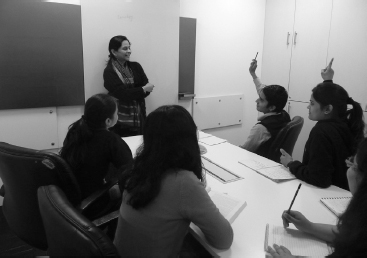
Figure 4.4 Lecture Method
Merits
- Lecture method is very economical because a single person can give knowledge to a large number of students at the same time. Also, no apparatus, equipment or material is needed.
- No special effort is required either from the teachers or from the students.
- Lecture method is simple, short and fast. This method saves time.
- It is easy and convenient for the teacher to deliver the lecture without bothering about demonstration or experiment.
- Very effective method for fact based knowledge and historical explanations.
- Very useful for the higher classes where large amount of knowledge needs to be transferred in a short span of time.
- This method is especially useful in certain situations such as introduction of the topic, instructions for some activity, revision of the content, etc.
Demerits
- It is not a psychologically sound method as more emphasis is laid on the content.
- This method does not provide opportunity for active involvement. Students only listen to the speaker.
- It does not give time to the students to grasp the matter. Most of the time lectures are delivered very fast.
- The speaker is not concerned, even if the listeners are not paying attention.
- Lectures cannot be given by everyone and anyone. Only some people are effective speakers.
How to Improvise?
- By using the blackboard as much as possible.
- By arranging the sub-topics of the lecture in a sequence from simple to complex.
- By asking questions during the lecture.
- By citing ample examples to clarify the concept.
2. Demonstration Method
Demonstration means to show. In this method, the teacher only shows certain phenomena, concepts or principles to provide concrete experience to the students. Demonstration may include the use of specimen, film slides, chemicals, equipments and experiments, etc. (Figure 4.5). By using the demonstration method, a teacher can:

Figure 4.5 Demonstration Method
- Co-relate the theory with practical.
- Provide concrete experience to the students.
- Help the students in solving problems.
- Do such demonstrations which are difficult and dangerous for the students to perform themselves.
- Use demonstrations to explain the process of experimentation/project and data collection.
- Enable the students to improve their observation power.
Merits
- Students remain active during the demonstration.
- Sophisticated and complicated apparatus can be used by the teacher which cannot be handled by the students.
- Less expensive and less apparatus is required.
- Less time is consumed.
- Concepts can be cleared easily through demonstration. They are more interesting also.
- This method is psychological as students are listening as well as observing.
- Scientific facts, principles and theories can be effectively proved through demonstration.
Demerits
- It is a teacher-centered method.
- Students do not get a chance to experiment.
- The individual differences of the students cannot be taken care of.
- The principle of learning by doing is neglected.
- Experimental skills of the students cannot be developed.
- Demonstrations are not effective if done in a large class room.
How to Improvise?
- Proper planning should be done in advance for the demonstration.
- Demonstration should be clearly visible to every student.
- Efforts should be made to involve the students also. This can be done by asking questions.
- Results of an experiment should not be told beforehand.
- Demonstration should not be very long.
- It should include only one idea at a time. Too many ideas may create confusion in students.
- Simple and clear language should be used by the teacher.
- Observations and results should be discussed in the class.
3. Lecture-cum-Demonstration Method
It is the most commonly used method by science teachers. Only the lecture method or only the demonstration method is practically not feasible. If a lecture is given in a proper sequence with illustrations or concrete experiences, it is helpful in learning. On the other hand, if a demonstration is given without any explanation, it serves no purpose. Any demonstration combined with discussion and questioning is an effective teaching technique.
Lecture-cum-demonstration method is thus, a combination of the lecture method and the demonstration method (Figure 4.6). A science teacher can change the ratio of the lecture and demonstration depending upon the age of the students and the topics being taught.

Figure 4.6 Lecture-cum-Demonstration Method
Merits and Demerits Lecture-cum-demonstration method has the same merits and demerits as that of demonstration method.
How to Improvise?
- Lecture-cum-demonstration should be clear and understandable to all.
- The main points, examples, beginning and ending statements should be repeated.
- It should not be monotonous. Stimulus variation should be introduced wherever appropriate.
- Too many points or demonstrations should not be taken up at one time. The 45 minutes period should be a mix of both, lecture and demonstration.
4. Laboratory Method
There is a talisman in science education which states “I heard and I forgot; I saw and I remembered; I did and I understood.” Science is a subject which can be learnt best by doing. The laboratory method is one such method which is based on this principle of learning by doing. In this method, students are totally involved in the activity. They perform experiments on their own in the laboratory. The teacher acts as a guide and supervisor. Students are provided with all the necessary materials and equipments. They are given proper instructions by the teacher. Then, the students perform the experiments, record the observations and draw inferences. The teacher goes to the students, observes what is being done, corrects them if something is wrong and is present there throughout the experiment. Thus, in this method, students gain permanent knowledge as they are always alert and active. (Figure 4.7).
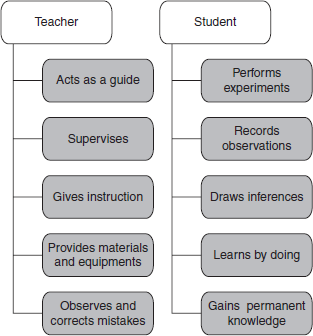
Figure 4.7 Role of Teacher and Student in Laboratory Method
Merits
- This method is based on the principle of learning by doing.
- It enables the students to learn on their own i.e., self study.
- Students get an opportunity to handle the materials themselves.
- This method facilitates training in a scientific method i.e., training in performing experiments, observing, recording data, interpreting results and drawing conclusions.
- The students are active throughout the class.
- Knowledge gained through this method is clear and permanent.
- Self-confidence of the students is enhanced.
- Weakness of each student can be identified and required help can be provided.
- Pupil-teacher relationship becomes stronger.
- The problem of indiscipline gets solved automatically as all the students are busy.
- Students learn to work in groups and thus, the spirit of cooperation develops.
Demerits
- It is an expensive method as separate equipments are needed for each student.
- This method is suitable for some specific type of topics only.
- For this method to be useful, teacher-student ratio has to be low, otherwise, the teacher cannot pay attention to each child.
- Expectation from students is high as they are expected to understand the instructions of the teacher and then work accordingly.
- Effort on the part of teacher is more as she is required to prepare the instructions well and then pay attention to each student individually.
- This method is not suitable for young children.
How to Improvise?
- To cater to a large number of students, the class can be divided into groups and different groups can do the experiments on different days.
- For a large class, different experiments can be set up for different students on the same day.
- Instructions to the students can be provided in a written format.
- The teacher can ensure that students follow the instructions properly.
5. Heuristic Method
The term heuristic has been derived from the Greek word ‘Heurisco’, which means to discover or find out. This method was given by Prof. H.E. Armstrong. He was a professor of chemistry in London. He was dissatisfied with the traditional method of teaching in which books were the main source of knowledge. He advocated that facts and information should be gathered by the students on their own. For this, he gave a scientific approach known as heuristic approach and the method followed is heuristic method. This method develops the attitude of discovery among the students. Actually, heuristic method does not intend for being a separate method, but it incorporates any method which enables the development of scientific enquiry.
In heuristic method, students are given a problem and all the necessary instructions to solve it. All the aspects of the problem are discussed with the students and then they are given freedom to find the solution. They themselves conduct experiments, make observations and draw conclusions and, finally, arrive at the result. (Figure 4.8).

Figure 4.8 Heuristic Method
Merits
- Students are actively involved.
- Follows the maxim of learning by doing.
- The spirit of enquiry is developed.
- The knowledge acquired is permanent.
- The relationship between the teacher and the students becomes stronger.
- The habit of self study, hard work are developed in the students.
- This method enables the development of a scientific attitude.
- There is no home workload on the students.
- Very time consuming process as the knowledge gained by the students is very less as compared to the time taken.
- Expectations from the students are very demanding.
- Efforts on the part of teachers increase as they have to plan and provide proper instructions sheets to the students.
- The syllabus cannot be covered in the whole session, if only this method is followed.
- Not feasible in the present circumstances as the number of students is too large in our schools.
- The available textbooks are not according to the discovery approach or method.
- Financial burden on the institution increases as sufficient material and equipment is needed.
- This method is not suitable for junior classes.
How to Improvise?
- The Heuristic method should be combined with the other methods.
- A few selected lessons should be taught by this method instead of the whole course.
6. Project Method
A project may be any purposeful activity. It may be the preparation of a working or static model, a chart or performing of an experiment. Working on a project involves the use of scientific knowledge. Students learn on their own with the help of this knowledge. The teacher acts as a guide and facilitator. Many times project involves finding out something that is not already known to the students. In such cases, it is known as an investigatory project. In this type of project, students themselves decide which experiment is needed and how it is to be performed. Sometimes, they may have to make their own apparatus, if it is not available. Students need to search for the desired principles, laws, formulae, etc. and find a solution.
Steps of the project method are:
- Problem
- Hypotheses
- Experimentation
- Collection of data
- Interpretation of data
- Conclusion
In the project method, a group of students select a problem after discussing with the teacher and formulate the hypotheses. They develop the plan of action, list the needed equipment, and conduct the experiment for testing the hypotheses. Then, they reach the conclusion. (Figure 4.9).
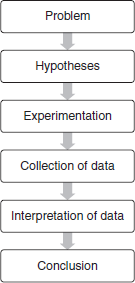
Figure 4.9 Steps of Project Method
Merits
- This method creates interest in science.
- Various concepts of science become clear.
- The qualities of self confidence, co-operation and leadership are developed.
- This is a psychological method based on learning by doing.
- The knowledge gained is permanent.
- Right use of leisure time is developed.
- Students work with their hands as well as apply their minds. Thus, integration of physical and mental activities is ensured.
Demerits
- It is a very difficult method for teacher as lot of planning and effort is required.
- It is not an economical method because more materials and equipments are needed.
- This method is very time consuming.
- The syllabus cannot be completed in a systematic and sequential manner.
How to Improvise?
- Students can be given responsibilities according to their capabilities.
- Freedom can be given for interaction among students.
- Definite objectives should be divided as well as achieved.
7. Problem Solving Method
It is a method which provides the students an opportunity to solve problems on their own by following some scientific steps. Here, the lesson starts with a problem and some possible solutions are thought by the students on the basis of their previous knowledge. Students themselves try to find out the best solution out of those possibilities. For this, the students may be involved in the self study, discussions, practical work, etc. In the problem solving method, it is very essential to state and understand the problem clearly. The steps followed in this method are (Figure 4.10):
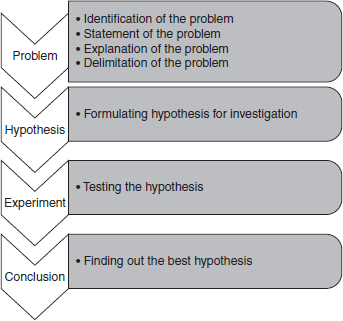
Figure 4.10 Problem Solving Method
- Problem:
- Identification of the problem
- Statement of the problem (clear description)
- Explanation of the problem (discussion, self-study)
- Delimitation of the problem (concentrating only on those parts of the problem which are within the reach of students)
- Hypotheses - formulating hypotheses for investigation
- Experiment - testing the hypotheses
- Conclusion - finding out the best hypotheses
Merits
- The habit of self-learning is developed.
- Students learn to understand and state the problems.
- The ability to collect and choose the relevant information is developed.
- Students can apply their acquired understanding to solve the problems of daily life.
- Students become able to select the best solution out of many possible solutions.
- A scientific attitude is inculcated.
- A healthy relationship develops between the teacher and the students.
Demerits The demerits are the same as that of the project method.
How to Improvise? The ways to improvise the method are the same as the project method.
8. Assignment Method
This method can be used for teaching theory as well as practical aspect of the syllabus. In this method, the whole course is divided into various parts according to the topics. These parts are known as assignments. These assignments are given to the students to be completed within a stipulated time. Students complete the work according to their abilities and capabilities by doing reference work. On the submission of one assignment, next assignment is given. Thus, different students will do different assignments at one point of time. The teacher acts as a guide and instructor. The teacher also ensures that assignments are checked and given on time. After completing theory of one topic, students go on to do assignments on practical aspect. Here, they also do the experiments in the laboratory as per the guidelines. They record the observations and complete the given assignment. After this, they move on to the theory of next topic.
There are four types of assignments depending on the work required from students. These are being depicted below (Figure 4.11):
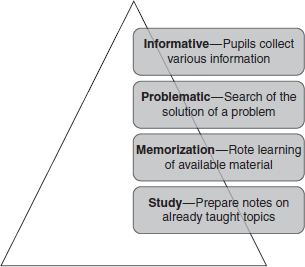
Figure 4.11 Types of Assignments
Characteristics of Good Assignment
- Purposeful
- Motivating
- Stimulating
- Definite and clear
- Interesting
- Related with previous knowledge
- According to individual differences
- Relevant, accurate
- Challenging
- Sequential
Merits
- Each student works according to his/her capacity. The individual differences are taken care of.
- Habits of self study, decision making are inculcated in students.
- Self dependency, sense of responsibility and self confidence are developed in the students.
- There is ample freedom of work. Duration of assignment is dependent on the mental and physical capabilities of the students.
- A healthy relationship develops between teachers and students.
- This method is based on the principle of activity.
- It is financially viable as the equipments and apparatus for one experiment are needed at different times by different students.
Demerits
- This method is not suitable for all kinds of learners. Students with low intelligence cannot comprehend the guidelines.
- Responsibility on teacher increases manifolds. He/she is required to prepare the assignments, write the instructions, allot the assignments, provide guidelines at proper time, ensure the availability of reference material and equipments, evaluate the assignment and give results. It is too much work for a teacher.
- Chances of cheating are more as the students may get tempted to copy the answers of questions and results of experiments.
- Not practical in the existing school conditions as text books written in this format are not available.
- There is a lack of trained teachers to teach through this method.
- The number of students in schools and classes is very large. Therefore, individual attention cannot be provided to everyone.
- The present examination system is not oriented to the assignment method.
How to Improvise?
- The assignments should be related to the topic.
- They should be clearly stated and given according to the age and capability of the students.
- The assignments should be well graded and systematic.
- To cater to a large number of students, the class can be divided into groups. One group may do the theory assignments and another group may be involved in the practical.
- Students may be instructed to keep a written record of their assignments.
- The guidelines should be well worded, simple and according to the comprehension level of the students.
9. Question Answer Method
“I keep six honest serving men. They taught me all I know. Their names are—What, When, Why, Where, How and Who.” This statement describes the importance of questions. Since ancient times, educationists have realized that teaching is incomplete without questions. Socrates propounded a method based on questions called as ‘Socrates Method’. According to this, the question answer method proceeded in the following manner (Figure 4.12):

Figure 4.12 Question Answer Method
- Framing the questions in a systematic and organized manner.
- Evoking curiosity among students by placing those questions.
- Co-relating various answers provided by students and thus, developing new knowledge.
In present times also, the question answer method is widely used for various purposes during the various stages of teaching, e.g., introduction, content presentation, comprehension, revision, etc. For different purposes the questions framed and asked are different. Generally, for introduction, very simple questions are asked from previous knowledge of the students. Similarly, for revision, questions are framed from the content taught on that day. Various types of questions have been depicted in Figure 4.13.

Figure 4.13 Types of Questions
Merits
- Students remain active throughout the class.
- Questions arouse curiosity among the students.
- This method is very useful for younger children.
- This method can be used effectively for various stages of teaching by making variations in questions.
- The question answer method is very useful for evaluation.
- This method enhances the power of logical thinking, reasoning and expression.
Demerits
- The teacher should be very motivated and enthusiastic to implement this method.
- The question answer method in itself is not complete. It should be combined with the other methods.
- Framing and asking questions require special skills among teachers.
- If questions are not formulated properly, this method may not solve any purpose.
How to Improvise?
- The questions should be asked in a simple language and in a clear manner.
- The questions should not be very long.
- Humor should be introduced in between questions.
- All the students should be involved.
- Suggestive questions (Yes/No types) should be avoided.
- The questions should be framed keeping in mind the age level of the students and the topics being taught.
10. Role Playing Method
Role playing method is based on the imitation of a role. This method is very helpful in bringing out changes in the personalities of the students. It can be used for various purposes. It can also be used to teach some simple topics to younger children, e.g., solar system, balanced diet. No time is given to practice the roles as they are given in the class itself and on the spot performance is presented by the students. The steps followed in this method are (Figure 4.14):
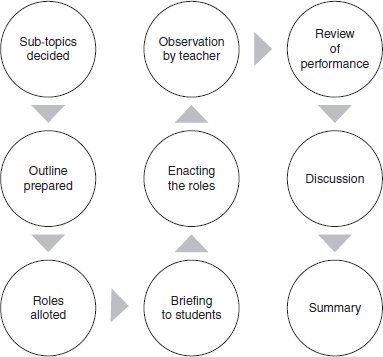
Figure 4.14 Role Play Method
- Topics to be taught are divided into sub-topics.
- An outline for role play is prepared by the teacher.
- The roles are allotted to the students.
- A briefing is given on how to play the roles.
- The roles are enacted.
- The teacher observes the role playing.
- The performance is reviewed.
- A discussion is held between the students and the teacher to summarize the lesson.
Merits
- This method gives proper chance for expression of feelings.
- Very useful method for primary and junior classes.
- This method is enjoyed a lot by the students.
- Some topics of science can be taught best by this method.
- Better relations are developed between students and teacher.
Demerits
- This method is suitable for junior classes only.
- An artificial atmosphere is created in the class during role play.
- Majority of topics cannot be taught by this method.
How to Improvise?
- Some time should be given to discuss and plan after the roles have been allotted.
- The teacher should supervise all the steps of role playing method right from preparing the outline to the review of the performance.
- At the end of class, a discussion should be held between the students and the teacher to assess the lesson.
11. Brain Storming Method
In this method, a problem is given to the students. Everybody gives their views on the problem and discusses it. Points emerging from the discussion are noted on the blackboard. Through this discussion and debate, a solution of the problem is found. This method gives chance to everyone to express their thoughts and contemplate on it. (Figure 4.15)
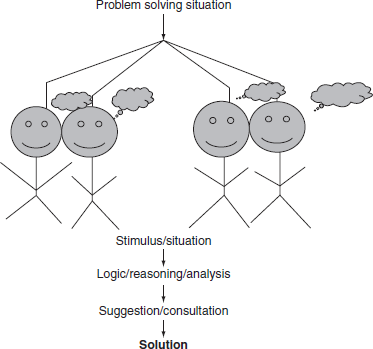
Figure 4.15 Brain Storming Method
Merits
- This method is based on psychological principles.
- Brain storming is useful in the higher classes.
- It encourages the students to express themselves.
- The inhibtiions of the students are removed.
- It enables the students to think independently, logically and critically.
- Brain storming encourages creativity.
Demerits
- This method is suitable for a very few topics.
- Brain storming is not applicable to junior classes at all.
- It is a very time consuming method.
- At the most, 6–7 topics can be identified to be taught by this method. Thus, brain storming can be used once in a month.
- The discussion can be guided by the teacher, so that, it does not go beyond the desired points.
- The teacher can summarize and conclude at the end of discussion.
SUMMARY
- Any teaching method is governed by 3 factors—teacher, student and environment.
- A teaching method should be selected on the basis of demographic characteristics of the classroom, infrastructure, practical utility and knowledge of the teacher.
- Some methods of teaching science are:
- Lecture method
- Demonstration method
- Lecture-cum-demonstration method
- Laboratory method
- Heuristic method
- Project method
- Problem solving method
- Assignment method
- Question answer method
- Role play method
- Brain storming method
- Every method has some merits and demerits.
- All the methods can be improvised by adopting appropriate measures.
- It is up to the discretion of the teacher to choose the most appropriate method, so that, learning can be at its maximum.
QUESTIONS
- Why is the lecture method more suitable for the higher classes?
- How is the lecture-cum-demonstration method better than only lecture method or only demonstration method?
- What precautions should be taken during a demonstration?
- Write the merits and demerits of demonstration method.
- What are the advantages and disadvantages of laboratory method?
- Explain the heuristic method in brief.
- Describe the process of the project method.
- What is a problem solving method? List down its various steps.
- Discuss the assignment method of teaching science. How is this method applicable in schools?
- Write short notes on:
- Role playing method
- Brain storming method
- Explain the various types of questions which can be asked during science teaching.
- Discuss briefly the different methods of teaching science. Which method is best suited to your class?
- What are the criteria for selecting an appropriate method of teaching science?
